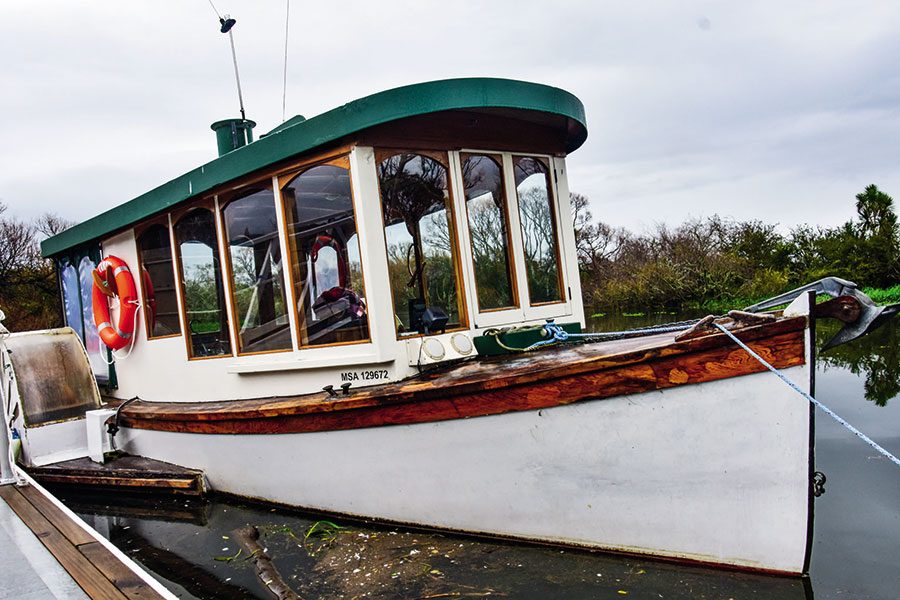

On one side, vehicles roar maniacally along the main road towards elsewhere. But on the other, a silent river idles gently by. And in between them is an oasis of peace, housing one of the most eclectic collections of maritime memorabilia in the country.
Like many motorists I’ve hurtled past, noted the masts, wheelhouses and boat bits, and kept on driving.
But this time was different – I needed to find information on the scow Owhiti and her legendary skipper Jock McKinnon. “They might just know,” I thought.
A group of older men clustered around the reception desk at the front of the crowded old building. “Well,” one of them said, “I think Peter sailed in her – I’ll give him a call.”
Peter duly turned up; a stocky and sprightly senior with a face wrinkled by a life of laughing and seafaring. We had a delightful long yarn about Owhiti, Skipper McKinnon, scows and scowmen. A history he brought out of the books and into life.
Conversation soon gravitated towards our location, the Paeroa Maritime Park.
 The diesel-powered paddle boat Tamati does river trips.
The diesel-powered paddle boat Tamati does river trips.
Centuries before, the first Maori plied the Ohinemuri River in great oceangoing waka long before Europeans arrived, but in November 1769, Captain James Cook RN sailed a cutter to Netherton, 7km north of Paeroa, and described a deep waterway lined with giant kahikatea trees. He named the waterway Thames after the river that ran through London in his homeland.
The Waihou and Ohinemuri exploration is said to be the furthest he ventured inland during his trip and the longest he was away from his ship, HMS Endeavour.
The river name reverted to Waihou in 1928 and a wharf was built at Paeroa to handle ships transporting machinery, freight and passengers for the burgeoning gold-mining industry on the Coromandel Peninsula, which accounted for the large part of the fledgling colony’s GDP.
Paeroa became, and remains, New Zealand’s most inland sea port.
By 1918, the advent of roads, motor vehicles and railways caused a decline in river boat trade until it ceased altogether in the late 1930s.
A remnant of Paeroa’s shipping heyday was the paddlewheel steam tug Kopu and in the late 1970s the Paeroa Historical Park Society, led by Alan Brimblecombe, was formed to salvage the derelict old river workhorse. The park’s riverside section was overgrown by gorse and littered with rubbish when the group took up residence in the on-site Ministry of Works workshop and slipway facility.
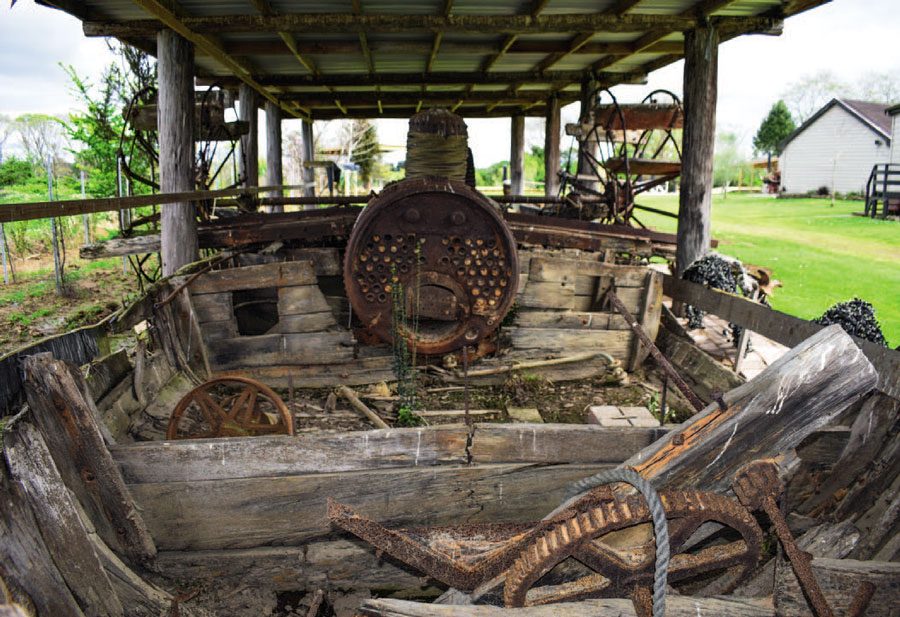
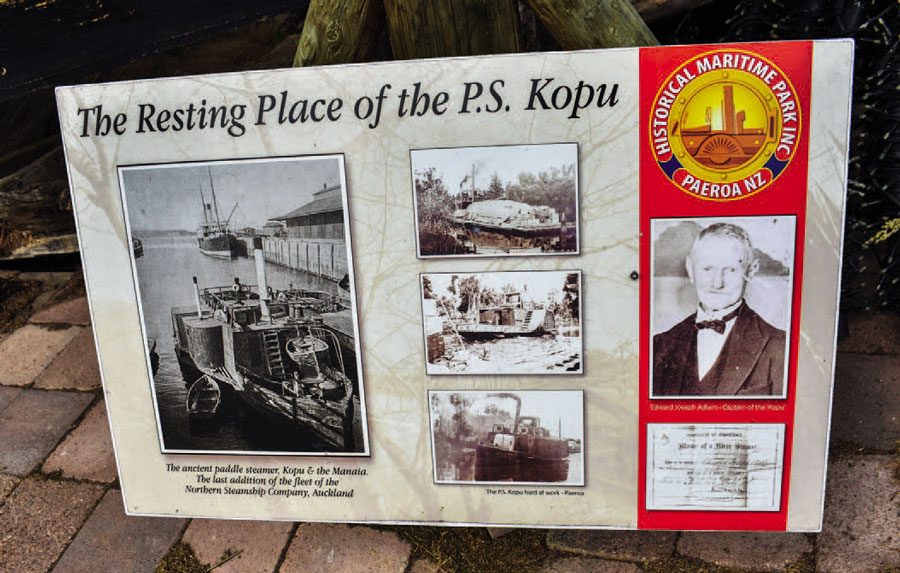 What remains of Kopu today and the information board at the museum telling her story.
What remains of Kopu today and the information board at the museum telling her story.
Membership grew steadily and in 1980 they were given the disused Waitekauri Post Office. Using grant money, it was relocated and refurbished and was opened as an office and museum in 1980.
With four walls to hold it, the park’s collection of things maritime began to burgeon. Initially it was equipment that had been used to ship the untold carats of gold extracted from deposits at Waihi and Karangahake, via Paeroa to Auckland, but over time more and more maritime memorabilia was donated to the fledgling museum.
Meanwhile a group of young people threw a party on the tug Kopu and left some sea cocks open when they left. The venerable old kauri craft settled into the mud where she was to stay for the next 46 years.
A motley collection of heritage vessels made their homes at the park – often their last resting place – and it became a collecting place for derelicts, both boats and people, deteriorating slowly and freely using the museum facilities but contributing little in return.
The maritime park had an ageing membership and a parlous financial situation – it was badly in need of new skills and energy.
 Exhibits include all sorts of historic and unusual craft, some restored, some not – even a surf boat.
Exhibits include all sorts of historic and unusual craft, some restored, some not – even a surf boat.
The whole operation looked like it was headed downhill at a rate of knots until a member invited Colin and Gloria James to the 2008 AGM. Colin found himself elected chairman and the maritime park turned a corner.
The James’ ran a Husqvarna tool shop in Paeroa and brought a new breath of solid business skills and entrepreneurship to the foundering park. Though neither had maritime experience or skills, they knew how to manage money and get the best from the eager and hardworking volunteers.
It took the next five years to clean up the grounds and repair the buildings – all done using voluntary labour with the most meagre funding and supplemented by help from Paeroa’s business community.
“It really is Paeroa’s museum,” trust secretary Gloria James said, “everybody helped: businesses, the Lions Club, Rotary – they could see what we were trying to achieve and all pulled together to give us a hand.”
The derelict boats tied to the rickety wharves and river banks slowly moved (or were moved…) on and the volunteer work force grew as people, who shared the vision for the future of Paeroa’s maritime treasures, joined in.
Meanwhile, the collection quickly grew to encompass a wonderful array of small boats, models, naval memorabilia, sailing ships, yachts and dredgers. “People have stuff lying around – left by a husband or father, that is too good to throw away but that needs to be got rid of and kept where it will be looked after,” she explained, “so they pass it on to us.”
The exhibits include a shapely Herreshoff picnic boat, skilfully crafted from kauri with a wicker seat and retractable oarlock frames. “It was badly burned in a fire,” she added, “the owners couldn’t fix it themselves but they stipulated that it was not to be stored in the water.”
One of the museum’s 50 volunteers took the beautiful boat under his wing and rebuilt her. Now she’s on display for visitors to marvel at or run their hands wonderingly along the smooth gunwale.
There’s a collection of navigational instruments; sextants and compasses. Precision tools that are redundant in this day of GPS but still very useable.
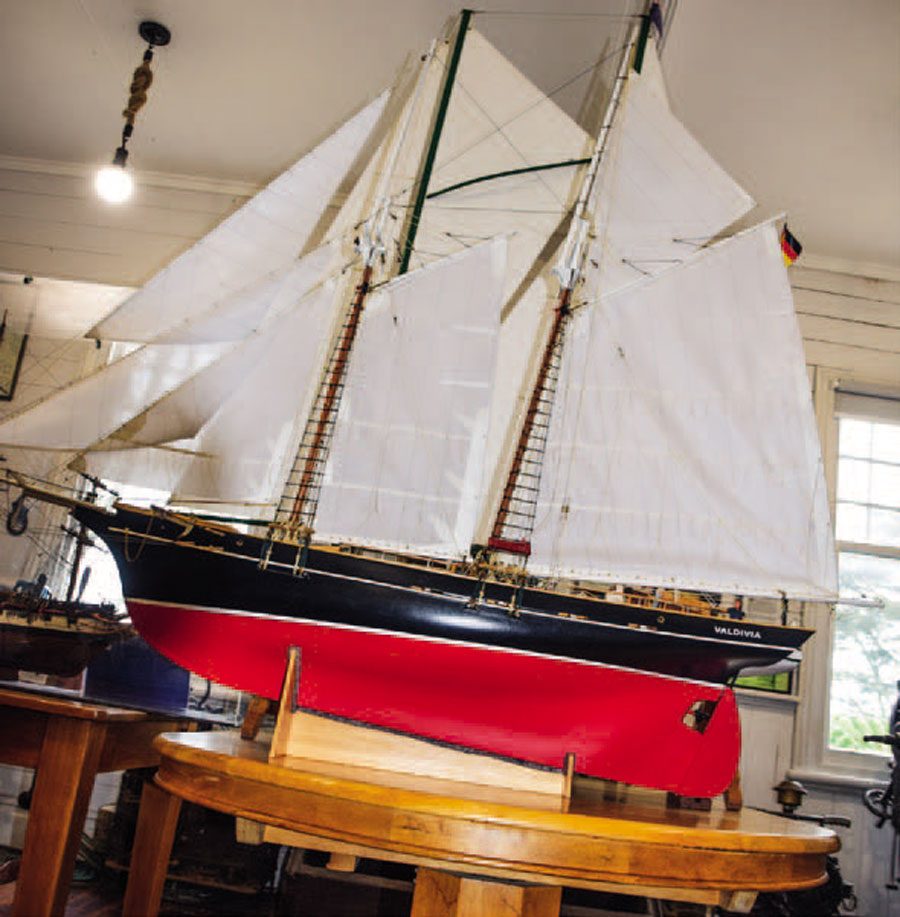
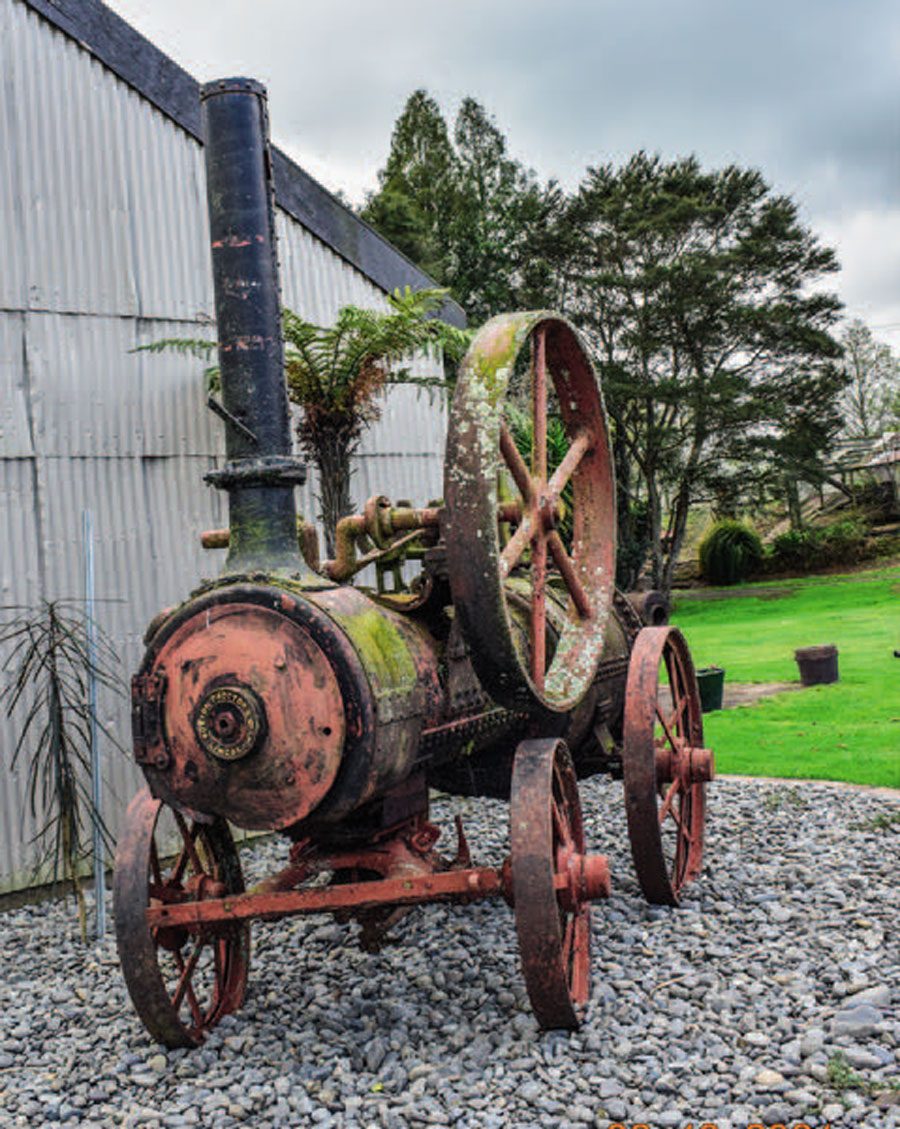
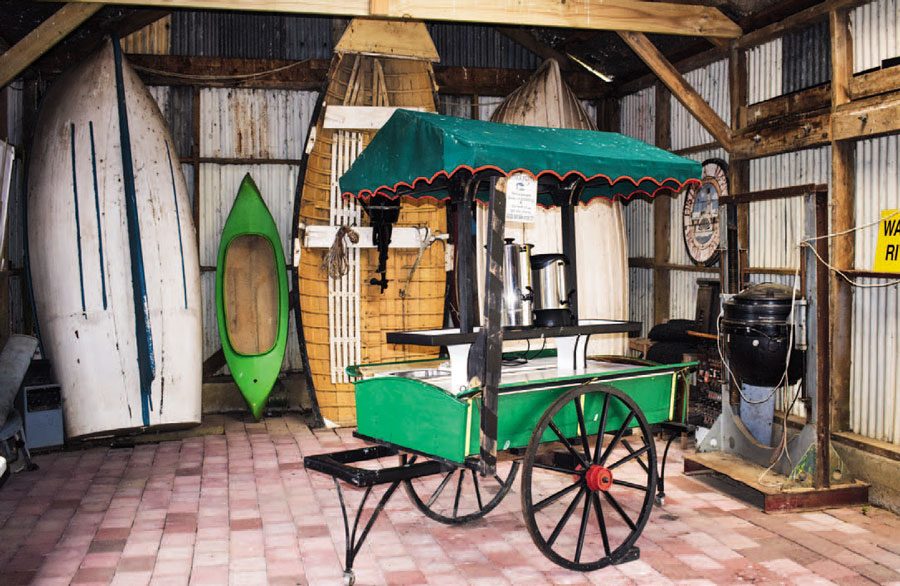 The museum and park contains an eclectic mix of historic exhibits, many of them donated by locals.
The museum and park contains an eclectic mix of historic exhibits, many of them donated by locals.
An ornate toilet bowl from the Elingamite, donated by diver Kelly Tarlton, gives cause to pause and consider the shipwreck which caused the loss of both the ship and 45 passengers one foggy morning in 1902 at West Island, in the Three Kings group north of New Zealand.
Elingamite rested, unseen on the sea floor, until Tarlton dived on
her in 1967.
I open a door, and a portrait of Captain Galloway, the former Wellington harbourmaster, stares implacably back at me. I remembered the time he’d given me a very thorough dressing down for playing silly buggers in his harbour with the garbage scow Success, and my ears burned.
“We’ve got his old uniforms, books, photographs and papers – the family wanted them kept in a safe place,” Gloria said.
An intricate model of the topsail schooner Valhalla under full sail made me wish I’d been born decades earlier.
In 2009, the couple bought a diesel-powered paddleboat, Tamati, which was used mostly for promotional work and river trips. She is now part of the Hauraki Rail Trail – cyclists or walkers can travel out from Paeroa, load their bicycles aboard and get dropped off at the rebuilt wharf in the town.
Kiteawa, an aluminium pontoon boat has been added to the fleet to allow access for disabled people or those in wheelchairs and the classic launch Ariana also does the run downriver.
Camper vans can park at the site to use the facilities provided for them but the only other full-time occupants are two growing families of Peking ducks. “The chicks get predated on by pukeko,” Gloria said, “so we catch them and put them in cages – with their mothers – until they’re old enough to defend themselves. They’re all hand-reared and very friendly.”
Another feature for the Paeroa Maritime Park people is the annual Christmas Lights Show when lights are strung through the trees, light standards and any elevated location in the park. “It’s the only show of its kind in the country,” Gloria says, “it attracts thousands of people from all over.”
Money from the annual twinkling lights of the park supports a number of local organisations throughout each year.
In 2010, funding from the Hauraki District Council enabled the museum building to be re-roofed and relined inside and a major refurbishment began.
Colin and Gloria James retired from the shop in Paeroa in 2014 and took on roles as full-time volunteers.

 The classic launch Ariana makes regular downriver runs.
The classic launch Ariana makes regular downriver runs.
“It’s a matter of matching our volunteers to what needs doing,” Gloria said. “Our volunteers are mostly senior – but they love what they’re doing and love coming here for the camaraderie and just contributing. We’ve got a huge pool of very skilled people.”
Funding was found for a full-time archivist to label and research all the existing artefacts at the museum, supported by Te Papa and Waikato Museum advisors.
A new wharf was built at Wharf Street in Paeroa and pontoons installed at the park. In 2019, an underground power network went in for camper vans and extended to the workshops where a traditional boatbuilding premises and stationary/marine motor maintenance and repair shop are planned.
An old warehouse, it’s walls lined with a bevy of shapely small vessels, can be used for functions and conferences.
A former Waikato Regional Council house from Paeroa is ready to be added to the museum – space for more maritime mementos.
New wharves and boardwalks wend along the riverbank, shady and overhung by trees. Plaques are fastened on the buildings for a bit of light reading en route. Outdoor displays, boats and winches, machine guns and attractive humpback bridges, the slumped and crumbling ruins of the old paddle wheeler Kopu with her rusty boiler – The Paeroa Maritime Museum and Park has a peaceful and restful other world ambience.
Just 150m away, traffic roars past, hurtling noisily towards Auckland or Tauranga.
But, it’s a world away from the tranquillity of the park and museum. BNZ




